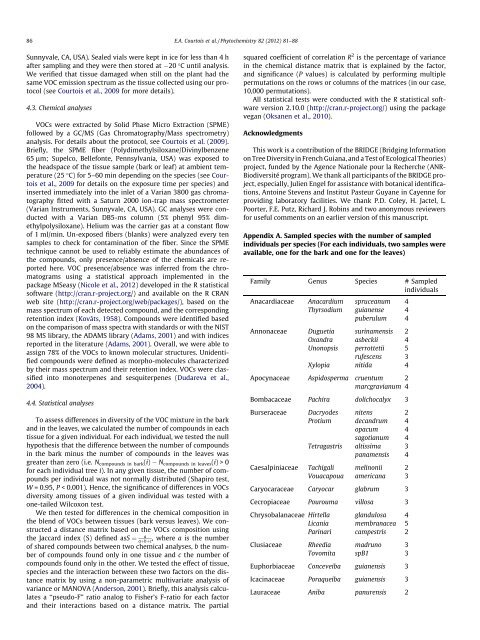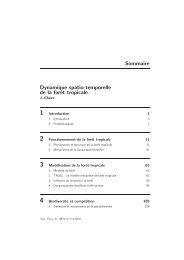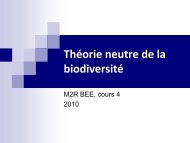86 E.A. Courtois et al. / Phytochemistry 82 (2012) 81–88Sunnyvale, CA, USA). Sealed vials were kept <strong>in</strong> ice for less than 4 hafter sampl<strong>in</strong>g and they were then stored at 20 °C until analysis.We verified that tissue damaged when still on the plant had thesame VOC emission spectrum as the tissue collected us<strong>in</strong>g our protocol(see Courtois et al., 2009 for more details).4.3. Chemical analysesVOCs were extracted by Solid Phase Micro Extraction (SPME)followed by a GC/MS (Gas Chromatography/Mass spectrometry)analysis. For details about the protocol, see Courtois et al. (2009).Briefly, the SPME fiber (Polydimethylsiloxane/Div<strong>in</strong>ylbenzene65 lm; Supelco, Bellefonte, Pennsylvania, USA) was exposed tothe headspace of the tissue sample (bark or leaf) at ambient temperature(25 °C) for 5–60 m<strong>in</strong> depend<strong>in</strong>g on the species (see Courtoiset al., 2009 for details on the exposure time per species) and<strong>in</strong>serted immediately <strong>in</strong>to the <strong>in</strong>let of a Varian 3800 gas chromatographyfitted with a Saturn 2000 ion-trap mass spectrometer(Varian Instruments, Sunnyvale, CA, USA). GC analyses were conductedwith a Varian DB5-ms column (5% phenyl 95% dimethylpolysiloxane).Helium was the carrier gas at a constant flowof 1 ml/m<strong>in</strong>. Un-exposed fibers (blanks) were analyzed every tensamples to check for contam<strong>in</strong>ation of the fiber. S<strong>in</strong>ce the SPMEtechnique cannot be used to reliably estimate the abundances ofthe compounds, only presence/absence of the chemicals are reportedhere. VOC presence/absence was <strong>in</strong>ferred from the chromatogramsus<strong>in</strong>g a statistical approach implemented <strong>in</strong> thepackage MSeasy (Nicole et al., 2012) developed <strong>in</strong> the R statisticalsoftware (http://cran.r-project.org/) and available on the R CRANweb site (http://cran.r-project.org/web/packages/), based on themass spectrum of each detected compound, and the correspond<strong>in</strong>gretention <strong>in</strong>dex (Kováts, 1958). Compounds were identified basedon the comparison of mass spectra with standards or with the NIST98 MS library, the ADAMS library (Adams, 2001) and with <strong>in</strong>dicesreported <strong>in</strong> the literature (Adams, 2001). Overall, we were able toassign 78% of the VOCs to known molecular structures. Unidentifiedcompounds were def<strong>in</strong>ed as morpho-molecules characterizedby their mass spectrum and their retention <strong>in</strong>dex. VOCs were classified<strong>in</strong>to mono<strong>terpene</strong>s and sesqui<strong>terpene</strong>s (Dudareva et al.,2004).4.4. Statistical analysesTo assess differences <strong>in</strong> diversity of the VOC mixture <strong>in</strong> the barkand <strong>in</strong> the leaves, we calculated the number of compounds <strong>in</strong> eachtissue for a given <strong>in</strong>dividual. For each <strong>in</strong>dividual, we tested the nullhypothesis that the difference <strong>between</strong> the number of compounds<strong>in</strong> the bark m<strong>in</strong>us the number of compounds <strong>in</strong> the leaves wasgreater than zero (i.e. N compounds <strong>in</strong> bark (i) N compounds <strong>in</strong> leaves (i)>0for each <strong>in</strong>dividual tree i). In any given tissue, the number of compoundsper <strong>in</strong>dividual was not normally distributed (Shapiro test,W = 0.95, P < 0.001). Hence, the significance of differences <strong>in</strong> VOCsdiversity among tissues of a given <strong>in</strong>dividual was tested with aone-tailed Wilcoxon test.We then tested for differences <strong>in</strong> the chemical <strong>composition</strong> <strong>in</strong>the blend of VOCs <strong>between</strong> tissues (bark versus leaves). We constructeda distance matrix based on the VOCs <strong>composition</strong> us<strong>in</strong>gthe Jaccard <strong>in</strong>dex (S) def<strong>in</strong>ed asS ¼a , where a is the numberaþbþcof shared compounds <strong>between</strong> two chemical analyses, b the numberof compounds found only <strong>in</strong> one tissue and c the number ofcompounds found only <strong>in</strong> the other. We tested the effect of tissue,species and the <strong>in</strong>teraction <strong>between</strong> these two factors on the distancematrix by us<strong>in</strong>g a non-parametric multivariate analysis ofvariance or MANOVA (Anderson, 2001). Briefly, this analysis calculatesa ‘‘pseudo-F’’ ratio analog to Fisher’s F-ratio for each factorand their <strong>in</strong>teractions based on a distance matrix. The partialsquared coefficient of correlation R 2 is the percentage of variance<strong>in</strong> the chemical distance matrix that is expla<strong>in</strong>ed by the factor,and significance (P values) is calculated by perform<strong>in</strong>g multiplepermutations on the rows or columns of the matrices (<strong>in</strong> our case,10,000 permutations).All statistical tests were conducted with the R statistical softwareversion 2.10.0 (http://cran.r-project.org/) us<strong>in</strong>g the packagevegan (Oksanen et al., 2010).AcknowledgmentsThis work is a contribution of the BRIDGE (Bridg<strong>in</strong>g Informationon Tree Diversity <strong>in</strong> French Guiana, and a Test of Ecological Theories)project, funded by the Agence Nationale pour la Recherche (ANR-Biodiversité program). We thank all participants of the BRIDGE project,especially, Julien Engel for assistance with botanical identifications,Anto<strong>in</strong>e Stevens and Institut Pasteur Guyane <strong>in</strong> Cayenne forprovid<strong>in</strong>g laboratory facilities. We thank P.D. Coley, H. Jactel, L.Poorter, F.E. Putz, Richard J. Rob<strong>in</strong>s and two anonymous reviewersfor useful comments on an earlier version of this manuscript.Appendix A. Sampled species with the number of sampled<strong>in</strong>dividuals per species (For each <strong>in</strong>dividuals, two samples wereavailable, one for the bark and one for the leaves)Family Genus Species # Sampled<strong>in</strong>dividualsAnacardiaceae Anacardium spruceanum 4Thyrsodium guianense 4puberulum 4Annonaceae Duguetia sur<strong>in</strong>amensis 2Oxandra asbeckii 4Unonopsis perrottetii 5rufescens 3Xylopia nitida 4Apocynaceae Aspidosperma cruentum 2marcgravianum 4Bombacaceae Pachira dolichocalyx 3Burseraceae Dacryodes nitens 2Protium decandrum 4opacum 4sagotianum 4Tetragastris altissima 3panamensis 4Caesalp<strong>in</strong>iaceae Tachigali mel<strong>in</strong>onii 2Vouacapoua americana 3Caryocaraceae Caryocar glabrum 3Cecropiaceae Pourouma villosa 3Chrysobalanaceae Hirtella glandulosa 4Licania membranacea 5Par<strong>in</strong>ari campestris 2Clusiaceae Rheedia madruno 3Tovomita spB1 3Euphorbiaceae Conceveiba guianensis 3Icac<strong>in</strong>aceae Poraqueiba guianensis 3Lauraceae Aniba panurensis 2
E.A. Courtois et al. / Phytochemistry 82 (2012) 81–88 87Sampled species with the number of sampled <strong>in</strong>dividuals perspecies (For each <strong>in</strong>dividuals, two samples were available,one for the bark and one for the leaves) (cont<strong>in</strong>ued)Family Genus Species # Sampled<strong>in</strong>dividualsOcotea argyrophylla 2percurrens 2Sextonia rubra 3Lecythidaceae Eschweilera congestiflora 3coriacea 3Lecythis persistens 4poiteaui 3Meliaceae Carapa procera 3Moraceae Brosimum guianense 5Myristicaceae Iryanthera hostmannii 2sagotiana 2Virola michelii 2Myrtaceae Myrcia decorticans 3Papilionaceae Bocoa prouacensis 2Rubiaceae Chimarrhis turb<strong>in</strong>ata 3Posoqueria latifolia 3Sap<strong>in</strong>daceae Cupania scrobiculata 5Sapotaceae Chrysophyllum argenteum 3Micropholis egensis 3guyanensis 5Pouteria gonggrijpii 3Simaroubaceae Simaba cedron 5Sterculiaceae Sterculia pruriens 4Theobroma sub<strong>in</strong>canum 3Tiliaceae Apeiba glabra 3Vochysiaceae Ruizterania albiflora 3ReferencesAdams, R.P., 2001. Identification of Essential Oil Components byGaschromatography/Quadrupole Mass Spectrometry. Carol Stream IL, USA.Anderson, M.J., 2001. A new method for non-parametric multivariate analysis ofvariance. Austral Ecology 26, 32–46.Baraloto, C., Pa<strong>in</strong>e, C.E.T., Pat<strong>in</strong>o, S., Bonal, D., Herault, B., <strong>Chave</strong>, J., 2010. Functionaltrait variation and sampl<strong>in</strong>g strategies <strong>in</strong> species-rich plant communities.Functional Ecology 24, 208–216.Baraloto, C., Hardy, O.J., Pa<strong>in</strong>e, C.E.T., Dexter, K.G., Cruaud, C., Dunn<strong>in</strong>g, L.T.,Gonzalez, M.-A., Mol<strong>in</strong>o, J.-F., Sabatier, D., Savola<strong>in</strong>en, V., <strong>Chave</strong>, J., 2012. Us<strong>in</strong>gfunctional traits and phylogenetic trees to exam<strong>in</strong>e the assembly of tropical treecommunities. Journal of Ecology 100, 690–701.Berenbaum, M., Neal, J.J., 1985. Synergism <strong>between</strong> myristic<strong>in</strong> and xanthotox<strong>in</strong>, anaturally cooccurr<strong>in</strong>g plant toxicant. Journal of Chemical Ecology 11, 1349–1358.Boege, K., 2005. Influence of plant ontogeny on compensation to leaf damage.American Journal of Botany 92, 1632–1640.Courtois, E.A., Pa<strong>in</strong>e, C.E.T., Bland<strong>in</strong>ieres, P.A., Stien, D., Bessiere, J.M., Houel, E.,Baraloto, C., <strong>Chave</strong>, J., 2009. Diversity of the <strong>volatile</strong> organic compounds emittedby 55 species of tropical trees: A survey <strong>in</strong> French Guiana. Journal of ChemicalEcology 35, 1349–1362.Dudareva, N., Pichersky, E., Gershenzon, J., 2004. Biochemistry of plant <strong>volatile</strong>s.Plant Physiology 135, 1893–1902.Feller, I.C., 2002. The role of herbivory by wood-bor<strong>in</strong>g <strong>in</strong>sects <strong>in</strong> mangroveecosystems <strong>in</strong> Belize. Oikos 97, 167–176.Feller, I.C., Mathis, W.N., 1997. Primary herbivory by wood-bor<strong>in</strong>g <strong>in</strong>sects along anarchitectural gradient of Rhizophora mangle. Biotropica 29, 440–451.Firn, R.D., Jones, C.G., 2003. Natural products – A simple model to expla<strong>in</strong> chemicaldiversity. Natural Product Reports 20, 382–391.Frankl<strong>in</strong>, J.F., Shugart, H.H., Harmon, M.E., 1987. Tree death as an ecological process.BioScience 37, 550–556.Gershenzon, J., 1994. Metabolic costs of terpenoid accumulation <strong>in</strong> higher-plants.Journal of Chemical Ecology 20, 1281–1328.Gershenzon, J., Dudareva, N., 2007. The function of <strong>terpene</strong> natural products <strong>in</strong> thenatural world. Nature Chemical Biology 3, 408–414.Gilbert, G.S., Hubbell, S.P., 1996. Plant diseases and the conservation of tropicalforests. BioScience 46, 98–106.Jones, C.G., Firn, R.D., 1991. On the evolution of plant secondary chemical diversity.Philosophical Transactions of the Royal Society of London, Series B – BiologicalSciences 333, 273–280.Kaplan, I., Halitschke, R., Kessler, A., Sardanelli, S., Denno, R.F., 2008. Constitutiveand <strong>in</strong>duced defenses to herbivory <strong>in</strong> above- and belowground plant tissues.Ecology 89, 392–406.Kováts, E., 1958. Gas-chromatographische charakterisierung organischerverb<strong>in</strong>dungen. Teil 1: retentions<strong>in</strong>dices aliphatischer halogenide, alkohole,aldehyde und ketone. Helvetica Chimica Acta 41, 1915–1932.Kursar, T.A., Dexter, K.G., Lokvam, J., Penn<strong>in</strong>gton, R.T., Richardson, J.E., Weber, M.G.,Murakami, E.T., Drake, C., McGregor, R., Coley, P.D., 2009. The evolution ofantiherbivore defenses and their contribution to species coexistence <strong>in</strong> thetropical tree genus Inga. Proceed<strong>in</strong>gs of the National Academy of Sciences of theUnited States of America 106, 18073–18078.Lago, J.H.G., de Avila, P., de Aqu<strong>in</strong>o, E.M., Moreno, P.R.H., Ohara, M.T., Limberger, R.P.,Apel, M.A., Henriques, A.T., 2004. Volatile oils from leaves and stem barks ofCedrela fissilis (Meliaceae): Chemical <strong>composition</strong> and antibacterial activities.Flavour and Fragrance Journal 19, 448–451.Lavandero, B., Labra, A., Ramírez, C.C., Niemeyer, H.M., Fuentes-Contreras, E., 2009.Species richness of herbivorous <strong>in</strong>sects on Nothofagus trees <strong>in</strong> South Americaand New Zealand: The importance of chemical attributes of the host. Basic andApplied Ecology 10, 10–18.Marquis, R.J., 1984. Leaf herbivores decrease fitness of a tropical plant. Science 226,537–539.Mart<strong>in</strong>, D.M., Gershenzon, J., Bohlmann, J., 2003. Induction of <strong>volatile</strong> <strong>terpene</strong>biosynthesis and diurnal emission by methyl jasmonate <strong>in</strong> foliage of Norwayspruce. Plant Physiology 132, 1586–1599.McCall, A.C., Fordyce, J.A., 2010. Can optimal defence theory be used to predictthe distribution of plant chemical defences? Journal of Ecology 98, 985–992.McKey, D., 1974. Adaptive patterns <strong>in</strong> alkaloid physiology. American Naturalist 108,305–320.Meurer-Grimes, B., Tavakilian, G., 1997. Chemistry of cerambycid host plants. Part I:Survey of Legum<strong>in</strong>osae – A study <strong>in</strong> adaptive radiation. Botanical Review 63,356–394.Mucciarelli, M., Camusso, W., Maffei, M., Panicco, P., Bicchi, C., 2007. Volatileterpenoids of endophyte-free and <strong>in</strong>fected pepperm<strong>in</strong>t (Mentha piperita L.):Chemical partition<strong>in</strong>g of a symbiosis. Microbial Ecology 54, 685–696.Mumm, R., Hilker, M., 2006. Direct and <strong>in</strong>direct chemical defence of p<strong>in</strong>e aga<strong>in</strong>stfolivorous <strong>in</strong>sects. Trends <strong>in</strong> Plant Science 11, 351–358.Nicole, F., Guitton, Y., Courtois, E.A., Moja, S., Legendre, L., Hossaert-McKey, M.,2012. MSeasy: unsupervised and untargeted GC-MS data process<strong>in</strong>g.Bio<strong>in</strong>formatics. http://dx.doi.org/10.1093/bio<strong>in</strong>formatics/bts427.Novotny, V., Wilson, M.R., 1997. Why are there no small species among xylemsuck<strong>in</strong>g<strong>in</strong>sects? Evolutionary Ecology 11, 419–437.Novotny, V., Basset, Y., Kitch<strong>in</strong>g, R., 2003. Herbivore assemblages and their foodresources. In: Yves Basset, V.N. (Ed.), Arthropods of Tropical Forests: SpatiotemporalDynamics and Resource Use <strong>in</strong> the Canopy. Cambridge UniversityPress, Cambridge, pp. 40–53.Ohnmeiss, T.E., Baldw<strong>in</strong>, I.T., 2000. Optimal defense theory predicts the ontogeny ofan <strong>in</strong>duced nicot<strong>in</strong>e defense. Ecology 81, 1765–1783.Oksanen, J., Blanchet, F.G., K<strong>in</strong>dt, R., Legendre, P., O’Hara, R.B., Simpson, G.L.,Solymos, P., Stevens, M.H.H., Wagner, H., 2010. Vegan: Community EcologyPackage. R package version 1.17-2.Pa<strong>in</strong>e, C.E.T., Stahl, C., Courtois, E.A., Patiño, S., Sarmiento, C., Baraloto, C., 2010.Functional explanations for variation <strong>in</strong> bark thickness <strong>in</strong> tropical ra<strong>in</strong> foresttrees. Functional Ecology 24, 1202–1210.Pearce, R.B., 1996. Antimicrobial defences <strong>in</strong> the wood of liv<strong>in</strong>g trees. NewPhytologist 132, 203–233.Pichersky, E., Gershenzon, J., 2002. The formation and function of plant <strong>volatile</strong>s:Perfumes for poll<strong>in</strong>ator attraction and defense. Current Op<strong>in</strong>ion <strong>in</strong> Plant Biology5, 237–243.Pimentel, D., Bellotti, A.C., 1976. Parasite-host population systems and geneticstability. The American Naturalist 110, 877–888.Poorter, H., Villar, R., 1997. The fate of acquired carbon <strong>in</strong> plants: Chemical<strong>composition</strong> and construction costs. In: Bazzaz, F.A., Grace, J. (Eds.), PlantResource Allocation. Academic press, London and New York, pp. 39–72.Price, P.W., Bouton, C.E., Gross, P., McPheron, B.A., Thompson, J.N., Weis, A.E., 1980.Interactions among three trophic levels: Influence of plants on <strong>in</strong>teractions<strong>between</strong> <strong>in</strong>sect herbivores and natural enemies. Annual Review of Ecology andSystematics 11, 41–65.Radhika, V., Kost, C., Bartram, S., Heil, M., Boland, W., 2008. Test<strong>in</strong>g the optimaldefence hypothesis for two <strong>in</strong>direct defences: Extrafloral nectar and <strong>volatile</strong>organic compounds. Planta 228, 449–457.





